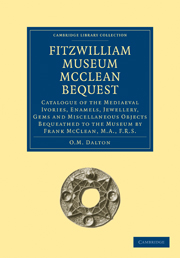 Fitzwilliam Museum McClean Bequest
Fitzwilliam Museum McClean Bequest That part of Mr McClean's Bequest described in this Catalogue, though not of great extent, is yet an acquisition of exceptional importance to the University. It contains classes of objects hitherto almost unrepresented in the Fitzwilliam Museum, and rapidly growing so rare that the hope of acquiring them through ordinary channels becomes every year more and more remote. They are the things for which collectors most obstinately compete; they belong to a very restricted group, of which the conspicuous members have been preserved for centuries in sacristies, or have passed in recent times into great permanent collections. The church treasuries, the museums, and the cabinets of wealthy amateurs have between them almost exhausted the visible sources of supply. The finer products of mediaeval handicraft, if they appear at all in the sale-rooms, change hands upon terms which would have seemed incredible to the collectors of fifty years ago.
There are many reasons why mediaeval objects should have thus appreciated in value. Their total number is relatively small, and is not likely to be increased by discovery: in this province great surprises are improbable. The places where the more important works of art are preserved are known ; even the typical examples of no more than average merit have almost all emerged from obscurity into positions of comparative prominence. It is not with these things as with Egyptian, or classical, or barbaric antiquities, the sum of which may at any moment be notably increased by the discovery of new tombs or cemeteries. They belong to the Christian epoch; and Christianity, by abolishing the custom of burying valuable possessions with the dead, deprived archaeology of a resource consistently available in the case of earlier periods.
To save this book to your Kindle, first ensure [email protected] is added to your Approved Personal Document E-mail List under your Personal Document Settings on the Manage Your Content and Devices page of your Amazon account. Then enter the ‘name’ part of your Kindle email address below. Find out more about saving to your Kindle.
Note you can select to save to either the @free.kindle.com or @kindle.com variations. ‘@free.kindle.com’ emails are free but can only be saved to your device when it is connected to wi-fi. ‘@kindle.com’ emails can be delivered even when you are not connected to wi-fi, but note that service fees apply.
Find out more about the Kindle Personal Document Service.
To save content items to your account, please confirm that you agree to abide by our usage policies. If this is the first time you use this feature, you will be asked to authorise Cambridge Core to connect with your account. Find out more about saving content to Dropbox.
To save content items to your account, please confirm that you agree to abide by our usage policies. If this is the first time you use this feature, you will be asked to authorise Cambridge Core to connect with your account. Find out more about saving content to Google Drive.